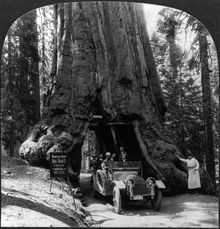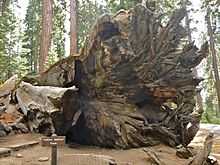Wawona Tree

The Wawona Tree, also known as the Wawona Tunnel Tree, was a famous giant sequoia that stood in Mariposa Grove, Yosemite National Park, California, USA, until 1969. It had a height of 227 feet (69 m) and was 26 feet (7.9 m) in diameter at the base.[1]
Native Americans named giant sequoia trees Wawona, which to them sounded like the hoot of an owl. The owl was considered the guardian spirit, the deity of these trees. The literal meaning of Wawona, translated from Miwok, is 'big trees'.

History

A tunnel was cut through the tree in 1881, enlarging an existing fire scar. Two men, the Scribner brothers, were paid $75 for the job ($1,833 in inflation-adjusted terms). The tree had a slight lean, which increased when the tunnel was completed. Hired by the Yosemite Stage and Turnpike Company to create a tourist attraction, this human-made tunnel became immensely popular. Visitors were often photographed driving through or standing in the tunnel.
Construction of the Wawona Tree was part of an effort by the Park Service to increase tourism in the age of the automobile. Stephen Mather the first Director of the National Park Service, was a main supporter of building a tourist clientele for the parks, which would in turn attract increasing appropriations from Congress and establish the Park Service as a legitimate and noteworthy bureaucratic agency.[2] Mather and his chief aid, Horace Albright, who would also be his successor, worked to make the parks as accessible as possible and, through drive-thru attractions such as the Tunnel Tree, as memorable as possible. Mather and Albright had already worked on the “See America First” campaign, trying to connect with western railroads to increase visitation to the parks. In the 1920s, the Park Service actively promoted automobile tourism. Roads and roadside attractions bloomed on the sites of Yellowstone, the Grand Canyon, and Yosemite. Roads, they believed, would also increase accessibility for “those who are not as strong and agile as you and I, for they too are entitled to their inspiration and enjoyment,” as Albright stated in a 1931 letter about roads in the Smokies. Around this time, the term 'scenic drive' became introduced into the national vocabulary.[3] The Wawona Tree may also have served as the inspiration for the 1946 children's book,Big Tree, by Mary and Conrad Buff.
The Wawona Tree fell in 1969 under a heavy load of snow on its crown. The giant sequoia is estimated to have been 2,300 years old. When the giant tree fell, there was much debate over what to do with it. It has remained where it fell primarily for ecological reasons, but still serves as a popular tourist destination. Because of their size, giant sequoias can create vast new ecosystems when they fall, providing habitat for insects and animals and allowing new plant growth.[4] It is now known as the Fallen Tunnel Tree.
Visitors to nearby Sequoia National Park sometimes confuse Yosemite's Fallen Tunnel Tree with Sequoia National Park's Tunnel Log.[5] A modest notice of both the Wawona Tree and another tunnel tree appears in the May 28, 1899 issue of a Sacramento Daily Union article: “In the lower grove there is another tree through which the wagon road runs. It is named California and is twenty-one feet in diameter at the base and 248 feet in height.”[6]
See also
| Wikimedia Commons has media related to: |
References
- ↑ "Frequently Asked Questions, Tunnel Tree". Sequoia and Kings Canyon National Parks. National Park Service. Retrieved 2013-11-27.
- ↑ Allin, Craig W. (1987). "9: Wilderness Preservation as a Bureaucratic Tool". In Foss, Phillip O. Federal Lands Policy. New York: Greenwood Press. pp. 130–131.
- ↑ Pierce, Daniel S. (2003). "9: The Road to Nowhere Tourism Development versus Environmentalism in the Great Smoky Mountains". In Starnes, Richard D. Southern Journeys: Tourism, History, and Culture in the Modern South. Tuscaloosa, AL: University of Alabama Press. pp. 200–201.
- ↑ "When Giants Fall". American Forests 117 (4): 12. Winter 2012.
- ↑ Johnson, Terrell (Feb 19, 2013). "The World's 20 Most Amazing Tunnels". weather.com Travel. Retrieved 2013-02-19.
- ↑ Leitch, B. M. (28 May 1899). "California's Big Trees". Sacramento Daily Union (96). Retrieved 25 June 2014.
Further reading
- Hewes, Jeremy Joan (1984). Redwoods: The World's Largest Trees. New York: Gallery Books. ISBN 978-0831773816.
Coordinates: 37°30′53.29″N 119°35′41.63″W / 37.5148028°N 119.5948972°W
| |||||||||||||||||||||||||||||||||||||
